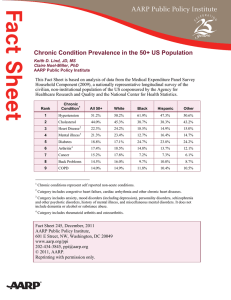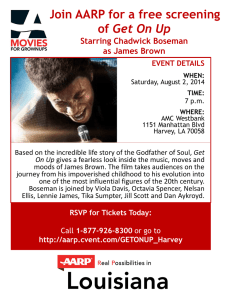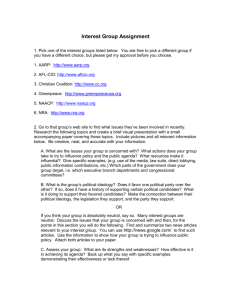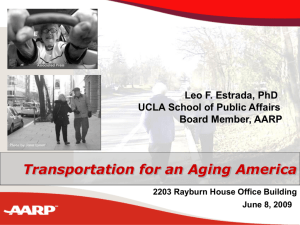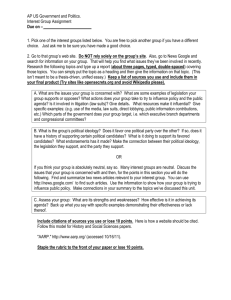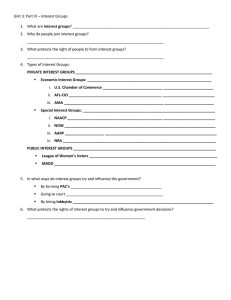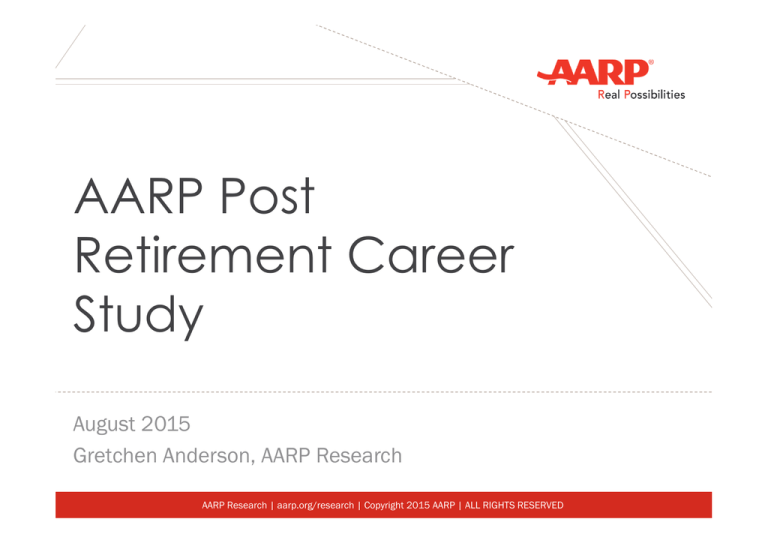
AARP Post
Retirement Career
Study
August 2015
Gretchen Anderson, AARP Research
AARP Research | aarp.org/research | Copyright 2015 AARP | ALL RIGHTS RESERVED
Table of Contents
Work Job Study
Background & Objectives
Executive Summary
Audience Profile
Post-Retirement Work
Appendix
Methodology
AARP Research | aarp.org/research | Copyright 2015 AARP | ALL RIGHTS RESERVED
3
4-5
6-11
13-21
22-26
25
2
Objectives
• To gather insights around mid-life adults’ thoughts
and intentions to work in retirement.
• To determine the type of work and work
arrangement they would like to have in retirement,
and the training and skills they think they will need.
• To gather insights on the mid-life Americans’
feelings on their current careers and when the plan
to retire.
AARP Research | aarp.org/research | Copyright 2015 AARP | ALL RIGHTS RESERVED
3
Executive Summary
•
The most popular age for retirement falls between 65-69 (45%). The balance of respondents
are split between retiring early, before the age of 65 (23%), or late, at 70+ (26%). Very few
(6%) have no plans to retire.
•
In total, more than one-third of respondents (37%) anticipate working for pay post retirement
from their current career.
– As expected retirement age increases, so does the likelihood of wanting to work for pay
in retirement.
•
Among those who will seek employment post retirement, almost half (44%) will be looking to
work in new fields of interest; 23% will stay in the same field, and 33% are undecided.
•
Regardless of the field, they are hoping to work part-time, with the majority expecting to work
for someone else (57%) vs. being a contractor or starting their own business.
•
For some, their dream job is about the profession, for others it is about a lifestyle.
– Jobs in the sports, creative, hospitality and education fields are mentioned frequently.
– Lifestyle mentions include flexibility, lucrative, offers travel opportunities, and has a
charitable aspect to it.
AARP Research | aarp.org/research | Copyright 2015 AARP | ALL RIGHTS RESERVED
4
Executive Summary
•
Training is a key need for those who plan to work in retirement. Among those who plan to
enter a new field, training is seen as even more important to success (46% vs. 36% among
those staying in the same field).
•
AARP’s work/job channel would benefit this audience by providing them access to the job
search resources they expect to use most often: job listings and professional networking
opportunities.
AARP Research | aarp.org/research | Copyright 2015 AARP | ALL RIGHTS RESERVED
5
WORKER PROFILE
AARP Research | aarp.org/research | Copyright 2015 AARP | ALL RIGHTS RESERVED
6
Post Retirement Plans
•
Nearly 7 in 10 (68%) say they plan to retire at or after the age of 65. Age 65-69 is the most
popular age range for retirement.
–
•
A significantly higher proportion of those currently age 60-64 (53%) would retire at this age compared to those
under 60 (40% age 50-54 and 44% age 55-59).
Over one-third of respondents think they would pursue paid work if they decided to retire
from their current job today.
–
Those ages 50-55 (39%) and 55-59 (37%) are slightly more likely to anticipate working for pay than are those 60+
(33%).
Age of Retirement
23%
Work Scenarios
16%
37%
45%
22%
26%
6%
Work for Pay
Full Retirement
25%
Work as Volunteer
Don't Know
Base: Total Respondents (n=4975)
Q3: At what age do you think you will stop working for pay?
Q4: If you retired from your current job today and money were not a major concern, would you look for work in a different arrangement?
AARP Research | aarp.org/research | Copyright 2015 AARP | ALL RIGHTS RESERVED
7
Work for Pay by Age
• As the age of retirement increases so does the likelihood that someone
will work for pay.
Age of Retirement
Expect to Work for Pay
23%
42%
45%
37%
26%
30%
6%
70+
65-69
<65
Never
Base: Total Respondents (n=4975)
Q3: At what age do you think you will stop working for pay?
Q4: If you retired from your current job today and money were not a major concern, would you look for work in a different arrangement?
AARP Research | aarp.org/research | Copyright 2015 AARP | ALL RIGHTS RESERVED
8
Work Scenario Composition
•
•
•
•
Reviewing the retirement
plans by various
demographics, it appears
men are slightly more likely
to keep working than are
women, where as women are
more likely than men to work
as a volunteer post
retirement.
Those living in the Northeast
are more likely than those in
other regions to continue to
work for pay.
Current income levels also
have some influence on
future plans with those of
lower income slightly more
likely than higher earners to
work post retirement.
There are no significant
differences by ethnicity.
Base: Total Respondents (n=4975)
Base
Work for Pay
Work as
Volunteer
Full
Retirement
Don’t Know
Male
Female
2555
2420
39% *
34%
21%
28% *
25% *
21%
15%
17%
Caucasian/White
Hispanic
3862
532
37%
38%
25%
24%
23%
22%
15%
17%
African American/Black 627
Asian
455
36%
40%
24%
25%
22%
19%
18%
16%
Northeast
Midwest
South
West
985
797
2098
1095
40% *
37%
36%
35%
22%
25%
24%
28% *
21%
22%
25% *
22%
17%
17%
15%
15%
HH Income <$50K
HH Income $50,000$74,999
HH Income $75,000$99,999
796
39% *
19%
22%
19% *
1020
37%
25% *
21%
17% *
995
37%
25% *
23%
15%
HH Income $100,000+
2164
35%
27% *
24%
14%
‘*’Significantly different at a 95% confidence within demographic variable.
AARP Research | aarp.org/research | Copyright 2015 AARP | ALL RIGHTS RESERVED
9
Number of Fields
• Most respondents have been in three or fewer fields/industries during their career.
Number of Fields/Industries Throughout Career
b
29%
27%
26%
25%
c
31%
29%
28%
26%
a
20%
18%
17%18%
1
2
Work for Pay (n=1828) (a)
3
Work as Volunteer (n=1228) (b)
c c
14%15%
14%
12%
b
b
b
15%
14%
14%
11%
4
5+
Full Retirement (n=1131) (c)
Base: Total Respondents (n=4975)
Don't Know (n=788) (d)
Letters indicate a significant difference between groups at a 95% confidence.
Q2: How many different fields or industries have you worked in throughout your working career?
AARP Research | aarp.org/research | Copyright 2015 AARP | ALL RIGHTS RESERVED
10
Current Job Attributes
•
•
Those who will look for work post retirement are more likely than those going into full retirement to state they
enjoy less tangible benefits of work: challenging work, interesting work and learning new skills.
And although the most enjoyable aspect of all respondents’ work is Income, it is a significant source of
satisfaction for those who are entering full retirement (as are Benefits) compared to those who would work for
pay or volunteer.
–
A good schedule/balance is more important to respondents under the age of 60 (48% age 50-54 and 46% age 55-59)
compared to those 60+ (42%).
Most Enjoyable Work Characteristics (Ranked Top 3)
TOTAL
(n=4975)
See Appendix for first ranked
percentages
Base: Total Respondents (n=4975)
Q1: What are the top 3 things you
enjoy most about your work?
Ranked first, second or third.
Letters indicate a significant difference
between groups at a 95% confidence.
Work for Pay
(a)
Work as Volunteer
(b)
Full Retirement
(c)
Don’t Know
(d)
(n=1828)
(n=1228)
(n=1131)
(n=788)
58%
70%
abd
61%
Income
63%
64%
Benefits
46%
44%
45%
53%
abd
46%
Schedule/balance
45%
44%
44%
48%
a
47%
Coworkers
41%
40%
43%
40%
43%
Interesting work
40%
41%
c
41%
c
35%
42%
c
Challenging
39%
41%
c
43%
cd
33%
37%
c
Learning new
things/skills
21%
23%
c
20%
c
17%
20%
c
Other
4%
3%
6%
a
4%
4%
b
AARP Research | aarp.org/research | Copyright 2015 AARP | ALL RIGHTS RESERVED
11
POST-RETIREMENT WORK
AARP Research | aarp.org/research | Copyright 2015 AARP | ALL RIGHTS RESERVED
12
What Are They Looking For
•
•
Almost half (44%) are interested in working in a different field than their current job.
The majority would like to be an employee, they would also like to work part-time.
–
–
–
Women are significantly more likely to want to work as an employee (63%) compared to men (52%). They also indicate they
would like part-time work (78%) more so than men (68%).
African American/Black and Hispanic respondents are more likely to want to start their own business (24% and 25%
respectively) than non-Hispanic Whites (18%).
Adults age 50-54 (23%) and 55-59 (20%) are significantly more likely than those age 60-64 (14%) to say they would be an
entrepreneur.
Field of Work
Type of Worker
57%
Employee
13%
23%
33%
19%
Entrepreneur
73%
Full-time
3%
Other
Different
14%
21%
Contractor
44%
Same
Work Arrangement
Part-time
Don't know
0%
20%
40%
60%
Don't know/No preference
Base: Total Completes (Work for Pay) (n=1828)
Q6: Would the new work be in the same or different field as the one you are currently employed in?
Q7: Would you be working for someone else or would you be starting your own business? Q5: Would your new post-retirement work be full or part-time?
AARP Research | aarp.org/research | Copyright 2015 AARP | ALL RIGHTS RESERVED
13
What Are They Looking For
Same vs. Different Field
• The desire to be an employee
is significantly stronger when
anticipating a change in fields
compared to staying in the
same field.
Same Field
Different Field
(n=419)
(n=814)
Desired Position
4% *
2%
19%
46%
• Part-time work is preferred,
regardless of the field of
choice; however, those staying
in the same field are
significantly more likely than
those changing fields to
desire a full-time position.
Base: Respondents who would work for pay and have a chosen field
Q7: Would you be working for someone else or would you be starting your own business?
Q5: Would your new post-retirement work be full or part-time?
22%
*
16%
60% *
31%
Work Arrangement
12%
23%
11% 11%
*
78% *
65%
‘*’Significantly different at a 95% confidence.
AARP Research | aarp.org/research | Copyright 2015 AARP | ALL RIGHTS RESERVED
14
The Dream Job Defined - Profession
• Those who would work for pay in retirement, regardless of whether they
plan to change fields or not, have a variety of ideas for their dream job;
most notable were jobs in the sports, creative, hospitality and education
fields.
Base: Total Completes (Work for Pay) ((n=1000 coded)
Q10: What would be your dream job?
AARP Research | aarp.org/research | Copyright 2015 AARP | ALL RIGHTS RESERVED
15
The Dream Job Defined - Lifestyle
• From a lifestyle perspective, their dream job will allow them to work parttime, from home, allow them to travel, help others and be rich. A fun and
stress-free environment is also desired.
Base: Total Completes (Work for Pay) (n=1000 coded)
Q10: What would be your dream job?
AARP Research | aarp.org/research | Copyright 2015 AARP | ALL RIGHTS RESERVED
16
The Dream Job In Their Own Words…
Same Field
“Helping my current
customers be more
profitable.”
“Working in a spa at
an exotic resort.”
“Where I could
make a difference in
my current
profession.”
“As a consultant
training young people
to do what I do.”
“Doing the same work
I am doing now, but
setting my own
schedule, picking
which assignments I
choose to work on,,
getting paid A LOT.”
“I pretty much have it!
Good work/life
balance, decent
salary, good benefits,
sense of being
appreciated,
interesting work.”
“I teach college and
that’s about as close to
a dream job for me as
possible.”
Different Field
“Teaching, at the
conclusion of a nonteaching career.”
“Something creative,
perhaps a freelance
photographer, writer.”
“Involve some form of travel outside
the US, not supervised very much,
dynamic environment and collaborative
approach oriented job.”
“After my white collar
career, I want to
operate a food truck.”
“Work from home, set my own
hours, good pay,
interesting/fulfilling/important
work.”
“Any job that would
require travel.”
“Outdoor guide. i.e.
rafting guide, hiking
guide etc.”
Base: Total Completes (Work for Pay) ((n=1000 coded)
Q10: What would be your dream job?
AARP Research | aarp.org/research | Copyright 2015 AARP | ALL RIGHTS RESERVED
17
New Job Must-Haves
• Training is the key need among those planning to work in retirement, especially on
skills related specifically to the job.
–
–
Women anticipate a significantly higher need for training (46%) than do men (38%).
African American/Blacks (55%) and Hispanics (49%) also anticipate a higher need for training than nonHispanic Whites (39%). The desire for training among African Americans/Blacks is also significantly
higher than Asian Americans (39%).
60%
Must-Haves to be Competitive
42%
40%
32%
29%
27%
21%
18%
20%
7%
2%
0%
Training (NET)
Job specific
skills
Digital &
Presentation & New contacts &
computer skills public speaking
networking
Promotion
resources
Other
None
Base: Total Completes (Work for Pay) (n=1828)
Q8: Which of the following would you need in order to be competitive in your new role?
AARP Research | aarp.org/research | Copyright 2015 AARP | ALL RIGHTS RESERVED
18
New Job Must-Haves
Same vs. Different Field
• For those entering into a new field, there is a significantly higher need for training
compared to those staying in the same field.
– A future entrepreneur entering a new field has a strong desire for resources to help with
promotion of self/business (46% vs 30% of future entrepreneurs in same field).
Must-Haves to be Competitive
60%
Same Field (n=419)
Different Field (n=814)
46% *
40%
36%
35% *
35%
34%*
29%
20%
16%
25%
22%
18%
18%18%
8% 7%
1% 2%
0%
Training (NET)
Job specific
skills
Digital &
Presentation & New contacts &
computer skillspublic speaking networking
Base: Respondents who would work for pay and have chosen a field
Q8: Which of the following would you need in order to be competitive in your new role?
Promotion
resources
Other
None
‘*’Significantly different at a 95% confidence.
AARP Research | aarp.org/research | Copyright 2015 AARP | ALL RIGHTS RESERVED
19
The Job Search
•
Networking among personal contacts is the most popular avenue for finding a new job post
retirement. That said, job listings and professional networking are not far behind.
–
–
Women are more likely than men to use personal contacts (52% vs. 47%), job listings (47% vs. 40%),
and volunteering (13% vs. 9%).
Adults under 60 are more likely than those 60-64 to say they are starting their own business (18% vs.
13%)
Resources for Finding a Job
Personal contacts
49%
Job listings (NET)
43%
Online job listings
29%
Company job listings
26%
Professional networking
39%
Temp/Contract work
19%
Start own business/consulting
16%
Volunteering
10%
Other
2%
0%
20%
40%
60%
Base: Total Completes (Work for Pay) (n=1828)
Q9: How do you think you would find your new job?
AARP Research | aarp.org/research | Copyright 2015 AARP | ALL RIGHTS RESERVED
20
The Job Search
Same vs. Different Field
• Job listings (NET and online) would be used more by those entering a new field.
• Professional networking is a stronger resource for those who don’t plan to change
fields.
Resources for Finding a Job
46%
47%
Personal contacts
35%
Job listings (NET)
20%
Online job listings
22%
Company job listings
Professional networking
43% *
29% *
26%
46% *
34%
17%
19%
Temp/Contract work
17%
17%
Start own business/consulting
6%
Volunteering
12%
Same Field (n=419)
*
Different Field (n=814)
2%
2%
Other
0%
Base: Respondents who would work for pay and have chosen a field
Q9: How do you think you would find your new job?
20%
40%
60%
‘*’Significantly different at a 95%
confidence.
AARP Research | aarp.org/research | Copyright 2015 AARP | ALL RIGHTS RESERVED
21
APPENDIX
AARP Research | aarp.org/research | Copyright 2015 AARP | ALL RIGHTS RESERVED
22
Appendix: Job Enjoyment Ranking
Ranked First in Top Three Things Enjoyed Most About Work
Total
Base
50-54
55-59
60-64
Male
Female
(a)
(b)
(c)
(d)
(e)
(f)
4975
1840
1760
1375
2555
2420
Income
28%
28%
28%
27%
29%f
26%
Schedule/balance
15%
18%bc
14%
14%
14%
17%e
Challenging
15%
13%
16%a
16%a
16%f
13%
Interesting work
14%
13%
14%
16%a
16%f
12%
Coworkers
12%
12%
13%
11%
10%
13%e
Benefits
11%
11%
11%
11%
10%
13%e
Learning new
things/skills
4%
5%
4%
4%
3%
5%e
Other
2%
1%
2%
1%
1%
2%e
Letters indicate a significant difference between groups at a 95% confidence.
AARP Research | aarp.org/research | Copyright 2015 AARP | ALL RIGHTS RESERVED
23
Appendix: Work Scenario Demos
Work for Pay
Work as Volunteer
Full Retirement
Don’t Know
(a)
(b)
(c)
(d)
1828
1228
1131
788
55% bd
45%
44%
56% acd
56% bd
44%
49% b
51% ac
39% cd
36%
25%
37%
36%
28%
35%
35%
30% a
35%
34%
31% a
77%
11%
12%
10% c
78%
10%
12%
9%
79%
10%
12%
8%
75%
11%
14%
10%
22% bc
16%
41%
21%
17%
16%
42%
25% acd
18%
15%
46% abd
21%
22% b
17%
41%
21%
<$50K
17% b
12%
16% b
20% bc
$50,000-$74,999
21%
20%
19%
22%
$75,000-$99,999
$100,000+
EMPLOYMENT
Full-time employee
Full-time self employed
20%
42%
21%
47% ad
20%
46% d
19%
39%
91% d
10%
89%
11%
91% d
9%
87%
13% ac
Base
GENDER
Male
Female
AGE
Age 50-54
Age 55-59
Age 60-64
ETHNICITY
Caucasian/White
Hispanic (% yes)
African American/Black
Asian
REGION
Northeast
Midwest
South
West
HOUSEHOLD INCOME
Letters indicate a significant difference between groups at a 95% confidence.
AARP Research | aarp.org/research | Copyright 2015 AARP | ALL RIGHTS RESERVED
24
Methodology
•
A 5-minute online survey was conducted among males and females age 50-64
who currently work full-time either as an employee or self-employed and who, if
retired from their job today, would look for paid work.
•
The survey was in field July 27–August 3, 2015.
•
A total of n=4975 respondents participated in this research with majority of
them answering only a portion of the survey, by design.
•
–
To understand the universe of those in or near retirement age, n=3147 respondents who were
outside of the qualifying criteria (would look for non-paid volunteer work, stay retired or didn’t
know what they would do) participated only through question #4.
–
The n=1828 respondents who qualified for the study completed the survey in its entirety through
question #10.
–
Note: During soft launch, those who “didn’t know” what they would do if they retired from their job
today were allowed to complete the entire survey; but, during full launch, those who “didn’t know”
were terminated after question #4. These respondents (n=68) were removed from the total
completes.
Final data has been weighted to the U.S. Census for analysis.
AARP Research | aarp.org/research | Copyright 2015 AARP | ALL RIGHTS RESERVED
25
Research Team
This research was designed and executed by
AARP 50+ Research:
AARP Research, 50+ Research
Gretchen Anderson, Senior Research Advisor
ganderson@aarp.org
In partnership with:
and
AARP Research | aarp.org/research | Copyright 2015 AARP | ALL RIGHTS RESERVED
26

